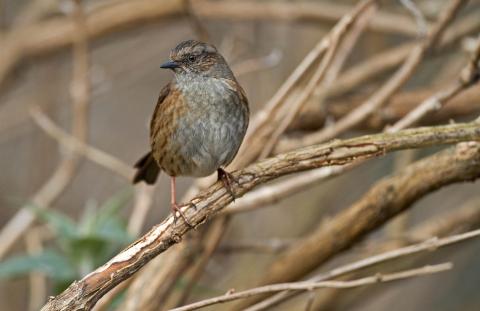Bird with name of Gaelic origin one of Ireland's commonest

The shy, brown Dunnock ("Donnóg" in Irish), or Prunella modularis, is one of Ireland's most common - and most sedentary - creatures, with a population of approximately 1 million and a lifelong travel radius of 1 km. By Niall Hatch.
One of Ireland’s most common and widespread birds, the Dunnock remains unknown to many, despite the fact that most well-planted gardens will have one or more in residence. This is because, unlike more colourful and showy garden birds such as the Robin and the Blue Tit, the Dunnock is a shy, skulking bird that prefers not to venture out into the open. It is much more at home creeping around, mouse-like, beneath bushes than on bird tables. If seed and left-over food scraps are left around the edges of the lawn, however, it may reveal its presence.
[Photo courtesy of Shay Connolly]
The English name of this species has Gaelic origins, and like the similar Irish name, it means “little brown thing”, a very apt description. It used to be more commonly known as the Hedge Sparrow, but this name has fallen out of favour as the Dunnock is not related to the sparrows at all but is instead the only Irish member of a family of birds called the accentors. It is, however, around the same size as a sparrow, measuring an average of 14 cm in length.
Predominantly streaky brown on the back, wings and top of the head, good views reveal that the breast and face are bluish-grey in colour. It has a slender, pointed bill, and pinkish legs which it uses to scuttle around on the ground and to clamber around bushes. In addition to gardens, Dunnocks are also commonly found in parks, hedgerows, scrub and gorse habitats and woodlands. One of the best ways to discover their presence in an area is to listen for their distinctive song: a rapid, scratchy warble that many people liken to the sound of an un-oiled shopping trolley wheel!
The Dunnock is amongst the most sedentary of Ireland’s birds, with most individuals moving no more that 1 km or so from the area where they were fledged. Surveys show that there may be as many as 1 million Dunnocks in Ireland, though they are a difficult species to census accurately.
